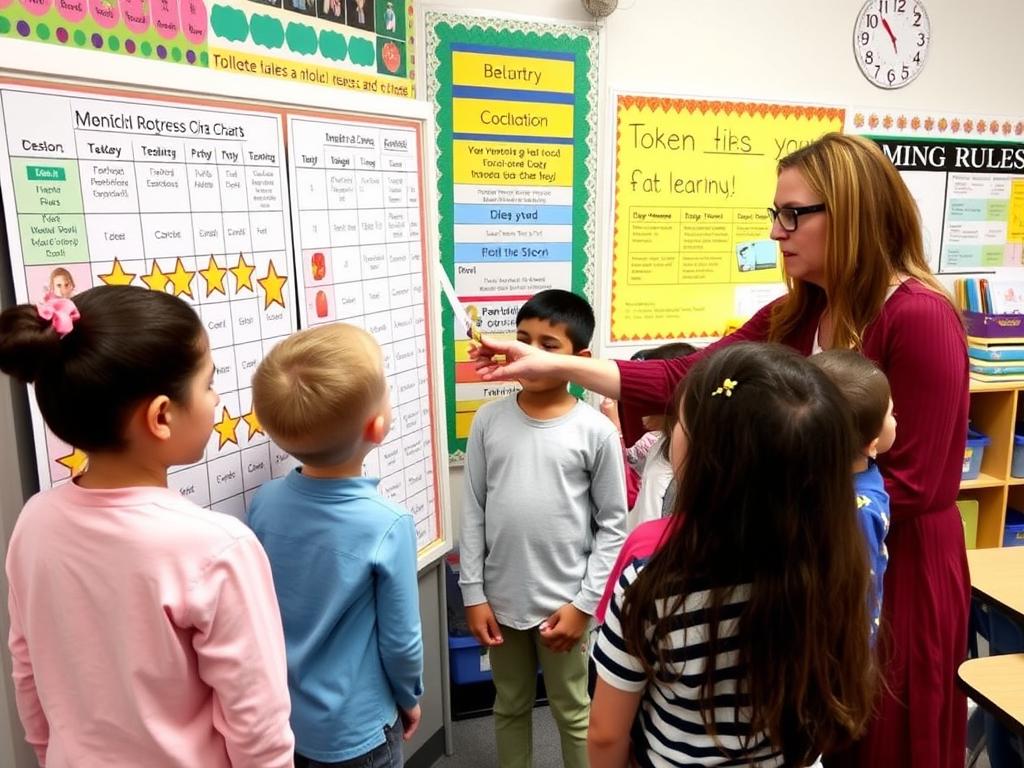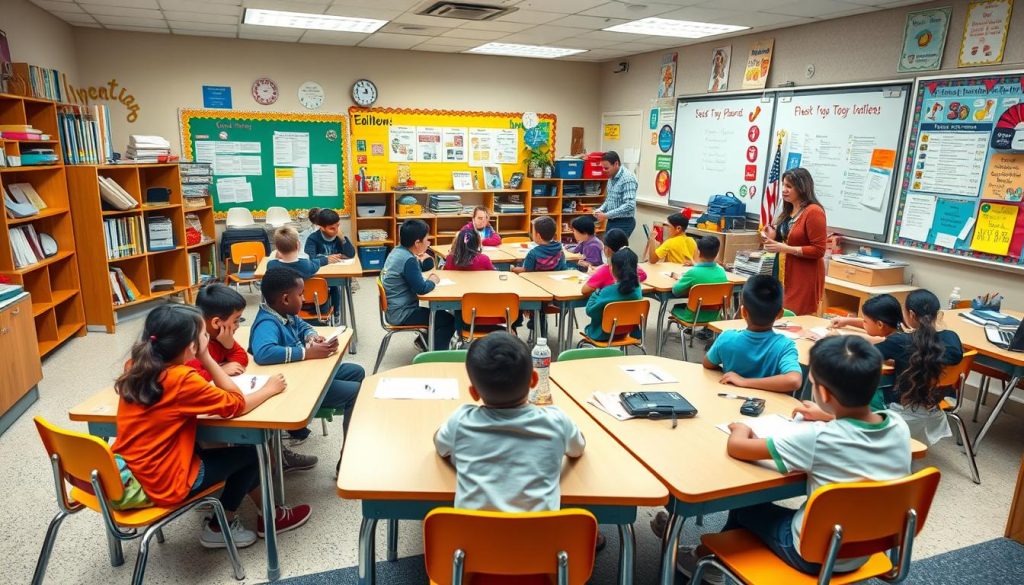In this comprehensive guide, we’ll explore the three key classroom management theories that have consistently demonstrated success in diverse educational settings. We’ll break down each theory’s core principles and provide actionable Top Strategies you can implement immediately. By enhancing your teacher skills through these evidence-based approaches, you’ll be better equipped to address behavioral challenges, maximize instructional time, and foster a positive classroom culture.
Behaviorist Theory: Top Strategies for Reinforcement-Based Management
The Behaviorist Theory of classroom management is founded on the principle that behavior is learned through interaction with the environment. This approach, pioneered by B.F. Skinner and other behavioral psychologists, focuses on how external stimuli and consequences shape student behavior. At its core, behaviorism suggests that behaviors followed by positive consequences are likely to be repeated, while those followed by negative consequences tend to diminish.
Understanding this cause-and-effect relationship is crucial for developing effective teacher skills in classroom management. When properly implemented, behaviorist strategies can significantly reduce disruptive behaviors while encouraging positive participation and academic engagement.
Key Principles of Behaviorist Classroom Management
The behaviorist approach operates on several fundamental principles that inform its practical applications:
- Positive reinforcement increases desired behaviors through rewards
- Negative reinforcement increases behaviors by removing aversive stimuli
- Punishment decreases unwanted behaviors
- Extinction reduces behaviors by removing reinforcement
- Consistent application of consequences is essential

Implementing Behaviorist Top Strategies in Your Classroom
Translating behaviorist theory into practical classroom management requires specific teacher skills and consistent implementation. Here are five evidence-based Top Strategies derived from behaviorist principles:
Token Economy Systems
Implement a structured reward system where students earn tokens (stickers, points, etc.) for positive behaviors that can later be exchanged for privileges or rewards. This system helps students make connections between their choices and outcomes while providing immediate positive feedback.
Behavior Contracts
Develop individualized agreements with students that clearly outline expected behaviors, consequences, and rewards. These contracts create accountability and give students agency in managing their own behavior, an essential teacher skills development area.
Clear Rules and Consequences
Establish explicit classroom rules with consistent, fair consequences for infractions. When students understand exactly what is expected and what will happen if rules are broken, they can make more informed behavioral choices.
According to a 2014 study published in the Journal of Educational Research, classrooms that implemented consistent behaviorist management techniques saw a 47% reduction in disruptive behaviors over a single semester. This research underscores the effectiveness of these approaches when applied with fidelity.
Enhance Your Behaviorist Management Skills
Looking to implement effective behaviorist strategies in your classroom? Discover professional development opportunities that can help you master these techniques and earn credits toward your continuing education requirements.
Humanistic Theory: Top Strategies for Student-Centered Management
The Humanistic Theory of classroom management takes a fundamentally different approach from behaviorism. Developed through the work of Carl Rogers and Abraham Maslow, this perspective emphasizes the importance of addressing students’ emotional and psychological needs as a foundation for effective learning. Rather than focusing primarily on external behaviors, humanistic management centers on developing students’ intrinsic motivation and self-regulation.
For teachers looking to expand their teacher skills repertoire, humanistic approaches offer powerful tools for creating classroom environments where students feel valued, understood, and empowered. This theory recognizes that when students’ basic needs for safety, belonging, and self-esteem are met, they become more engaged learners who take greater responsibility for their behavior.

Core Elements of Humanistic Classroom Management
The humanistic approach is built on several key principles that inform its implementation:
- Creating psychologically safe environments where students feel accepted
- Developing authentic teacher-student relationships based on mutual respect
- Encouraging student autonomy and self-directed learning
- Addressing Maslow’s hierarchy of needs in the classroom context
- Focusing on intrinsic rather than extrinsic motivation
Humanistic Top Strategies for Effective Classroom Management
Implementing humanistic principles requires specific teacher skills that foster connection, communication, and community. Here are five powerful Top Strategies derived from humanistic theory:
Morning Meetings
Begin each day with a structured community-building circle that includes greeting, sharing, group activity, and morning message components. This practice builds classroom cohesion and gives students a voice in the community.
Collaborative Rule-Setting
Involve students in creating classroom norms and expectations, fostering ownership and intrinsic motivation to follow rules they helped establish. This democratic approach is a cornerstone of humanistic management.
Restorative Practices
When conflicts arise, use restorative conversations that focus on repairing harm rather than punitive measures. This approach teaches conflict resolution as a valuable teacher skills component while maintaining student dignity.
The effectiveness of humanistic approaches is supported by research. A longitudinal study published in Teaching and Teacher Education found that classrooms employing humanistic management techniques showed significant improvements in student self-regulation and decreased behavioral issues over time.
“When students feel psychologically safe and valued as individuals, their capacity for self-regulation and engagement increases dramatically. The humanistic approach isn’t just about managing behavior—it’s about developing whole human beings.”
Dr. Thomas Gordon, Educator and Author
Master Love & Logic Approach
The Love & Logic methodology aligns perfectly with humanistic classroom management principles. This proven approach helps teachers develop essential teacher skills for creating respectful, responsible classroom communities.
Cognitive Theory: Top Strategies for Metacognitive Management
The Cognitive Theory of classroom management represents a bridge between behaviorist and humanistic approaches. Developed through the work of psychologists like Albert Bandura and Lev Vygotsky, this perspective focuses on how students’ thought processes influence their behavior. Cognitive classroom management emphasizes teaching students to monitor and regulate their own behavior through metacognitive strategies.
For teachers seeking to expand their teacher skills, cognitive approaches offer powerful tools for helping students develop self-awareness and internal control. This theory recognizes that when students understand the thinking behind their actions and learn strategies for self-regulation, they become more capable of making positive behavioral choices independently.

Fundamental Principles of Cognitive Classroom Management
The cognitive approach is built on several key principles that inform its implementation:
- Students’ behaviors are influenced by their thoughts and beliefs
- Self-regulation can be explicitly taught and developed
- Metacognitive strategies help students monitor their own behavior
- Social learning occurs through observation and modeling
- Executive functioning skills directly impact classroom behavior

Cognitive Top Strategies for Classroom Management
Implementing cognitive principles requires specific teacher skills that foster metacognition, self-awareness, and problem-solving. Here are five effective Top Strategies derived from cognitive theory:
Self-Monitoring Tools
Teach students to track and evaluate their own behavior using simple charts or digital tools. This develops metacognitive awareness and gives students ownership of their behavioral progress.
Cognitive Behavior Modification
Guide students through structured reflection on the thinking patterns that lead to problematic behaviors, then help them develop alternative thought processes. This approach addresses behavior at its cognitive source.
Executive Function Scaffolds
Provide explicit support for planning, organization, and time management through visual schedules, checklists, and other tools. These scaffolds help students develop crucial self-regulation teacher skills.
Research consistently supports the effectiveness of cognitive management approaches. According to a meta-analysis published in the Journal of Learning Disabilities, students who received explicit instruction in self-regulation strategies showed significant improvements in both academic performance and classroom behavior.
Develop Advanced Teacher Skills
Ready to implement cognitive management strategies in your classroom? Discover professional development opportunities that can help you master these techniques while earning credits toward your continuing education requirements.
Integrated Approach: Top Strategies for Comprehensive Management
While each classroom management theory offers valuable insights, today’s most effective educators recognize that an integrated approach often yields the best results. By thoughtfully combining elements from behaviorist, humanistic, and cognitive theories, teachers can develop a comprehensive management system that addresses diverse student needs and classroom situations.
This integrated approach requires advanced teacher skills in recognizing when different strategies are most appropriate. Rather than adhering rigidly to a single theory, effective teachers develop a flexible toolkit of Top Strategies they can deploy strategically based on specific contexts and individual student needs.
Benefits of an Integrated Management Approach
Adopting an integrated approach to classroom management offers several significant advantages:
Benefits of Integration
- Addresses the full spectrum of student needs and behaviors
- Provides multiple intervention options for different situations
- Combines short-term management with long-term skill development
- Balances external structure with internal motivation
- Adapts to diverse classroom contexts and student populations
Challenges to Consider
- Requires deeper understanding of multiple theories
- May be more complex to implement initially
- Demands thoughtful selection of compatible strategies
- Necessitates ongoing reflection and adjustment
- Requires strong teacher skills in multiple approaches
Integrated Top Strategies for Effective Classroom Management
Here are five powerful integrated strategies that combine elements from multiple management theories:
Responsive Classroom
This comprehensive approach integrates social-emotional learning with academic instruction, combining humanistic community-building with cognitive self-regulation strategies and clear behavioral expectations.
CHAMPS Framework
This structured system provides clear behavioral expectations (behaviorist) while teaching students to self-monitor their choices (cognitive) within a respectful classroom community (humanistic).
Zones of Regulation
This framework helps students identify their emotional states (cognitive) while providing structured supports (behaviorist) and emphasizing emotional awareness and empathy (humanistic).
The effectiveness of integrated approaches is supported by research. A comprehensive study in the Journal of Educational Research found that teachers who flexibly implemented strategies from multiple theoretical frameworks reported higher levels of student engagement and fewer persistent behavior problems than those who adhered strictly to a single approach.
“The most effective classroom managers are those who understand the theoretical foundations of different approaches and can thoughtfully integrate them to meet the needs of their unique classroom community.”
Dr. Carol Weinstein, Author of “Elementary Classroom Management”
Implementing Your Top Strategies: From Theory to Practice
Understanding classroom management theories is just the beginning. The real challenge—and opportunity—lies in translating these concepts into daily practice in your classroom. This implementation process requires both strategic planning and consistent execution, supported by ongoing reflection and refinement of your teacher skills.

Steps for Successful Implementation
Follow these structured steps to effectively implement your chosen classroom management Top Strategies:
- Assess Your Classroom Needs – Begin by identifying your specific classroom challenges and student needs. Different classes may require different management approaches.
- Select Compatible Strategies – Choose management strategies that complement each other and align with your teaching philosophy and classroom context.
- Create a Comprehensive Plan – Develop a written management plan that details your selected strategies, implementation steps, and assessment methods.
- Teach Expectations Explicitly – Dedicate time to teaching, modeling, and practicing classroom procedures and behavioral expectations with students.
- Implement Consistently – Apply your chosen strategies consistently while maintaining flexibility to address individual student needs.
- Monitor and Adjust – Regularly assess the effectiveness of your management approach and make data-informed adjustments as needed.
- Seek Ongoing Support – Engage with colleagues, mentors, or professional development to continuously refine your teacher skills in classroom management.
Common Implementation Challenges and Solutions
| Challenge | Solution | Theory Connection |
| Inconsistent implementation | Create visual reminders and use self-monitoring tools to maintain consistency | Cognitive (self-regulation) |
| Student resistance to new systems | Involve students in developing and refining classroom management approaches | Humanistic (student agency) |
| Managing diverse behavioral needs | Implement tiered supports with universal, targeted, and intensive interventions | Integrated (multi-level) |
| Maintaining momentum over time | Establish regular reflection cycles and refresher activities throughout the year | Behaviorist (reinforcement) |
| Balancing structure with flexibility | Create clear routines with built-in options for student choice and adaptation | Integrated (structure + autonomy) |
Transform Your Classroom Management
Ready to take your teacher skills to the next level? The Love & Logic approach offers practical strategies that integrate elements from all three management theories, providing a comprehensive framework for creating a positive, productive classroom environment.
Conclusion: Mastering Your Classroom Management Top Strategies
Effective classroom management is both an art and a science, requiring a thoughtful blend of theoretical understanding and practical application. By exploring the behaviorist, humanistic, and cognitive theories of classroom management, you’ve gained valuable insights into the diverse approaches available to today’s educators. More importantly, you’ve discovered specific Top Strategies from each framework that you can implement in your own classroom.
Remember that developing strong teacher skills in classroom management is an ongoing journey rather than a destination. The most effective educators continually refine their approach, adapting strategies to meet the evolving needs of their students and classroom community. By maintaining this growth mindset, you position yourself to create a learning environment where both you and your students can thrive.

As you move forward in implementing these Top Strategies, remember that consistency, reflection, and adaptation are key to success. Start small by selecting one or two approaches from each theoretical framework that resonate with your teaching style and classroom needs. As these become integrated into your practice, gradually expand your management toolkit to create a comprehensive system that supports all students.
By investing in developing your teacher skills through continuous learning and practice, you’re not only enhancing your classroom management capabilities but also contributing to your students’ academic success and social-emotional development. The strategies you implement today will help shape the learning experiences and opportunities available to your students for years to come.
Continue Your Professional Growth
Ready to deepen your understanding of classroom management and earn credits while enhancing your teacher skills? Explore our comprehensive resources and professional development opportunities designed specifically for K12 educators.




